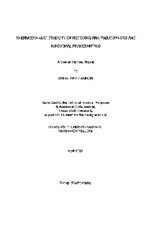| dc.contributor.advisor | Giedroc, David P. | |
| dc.creator | Cannon, Brian Ray | |
| dc.date.accessioned | 2013-02-22T20:39:35Z | |
| dc.date.available | 2013-02-22T20:39:35Z | |
| dc.date.issued | 2001 | |
| dc.identifier.uri | https://hdl.handle.net/1969.1/ETD-TAMU-2001-Fellows-Thesis-C359 | |
| dc.description | Digitized from print original stored in HDR. Due to the character of the original source materials and the nature of batch digitization, quality control issues may be present in this document. Please report any quality issues you encounter to digital@library.tamu.edu, referencing the URI of the item. | en |
| dc.description | Includes bibliographical references (leaves 22-23). | en |
| dc.description | Program year: 2000/2001 | en |
| dc.description.abstract | Programmed ribosomal frameshifting is a method of regulation of protein expression in which a change in reading frame during translation brings about the formation of an alternative gene product. This process is an important part of the replicative machinery of many RNA viruses, including HIV-1, the causative agent of AIDS. Programmed -1 frameshifting is commonly stimulated via an as yet undetermined mechanism that requires an RNA structural motif in the mRNA coding sequence known as an RNA pseudoknot, found just downstream of the site of -1 slippage. Recently, it was shown that engineering two structural features of the pseudoknots derived from tobacco yellow mosaic virus (a specifically placed loop 2 adenosine), TYMV, and mouse mammary tumor virus (an unpaired adenosine at the stem 1 - stem 2 junction), MMTV could restore efficient frameshifting to a functionally inactive pseudoknot. Thermodynamic analysis presented here shows that a mutant pseudoknot lacking the loop 2 adenosine forms a pseudoknot structure which is stabilized by 1.4 ± 0.5 kcal mol⁻¹. In contrast, two other pseudoknots, in which the junction adenosine residue was substituted with guanosine and the and the other one in which the loop 2 adenosine was replaced with guanosine, both formed moderately less stable structures. All three RNAs display frameshifting efficiencies greatly reduced relative to the wild type RNA. Although these findings suggest that there is no clear correlation between pseudoknot stability and frameshifting efficiency, our data does suggest that a specific interaction between a loop 2 iv adenosine and helical stem 1 makes a measurable contribution to pseudoknot stability. | en |
| dc.format.extent | 32 pages | en |
| dc.format.medium | electronic | en |
| dc.format.mimetype | application/pdf | |
| dc.language.iso | en_US | |
| dc.rights | This thesis was part of a retrospective digitization project authorized by the Texas A&M University Libraries in 2008. Copyright remains vested with the author(s). It is the user's responsibility to secure permission from the copyright holder(s) for re-use of the work beyond the provision of Fair Use. | en |
| dc.subject | RNA | en |
| dc.subject | RNA pseudoknot | en |
| dc.subject | ribosomal frameshifting | en |
| dc.subject | replication | en |
| dc.title | Thermodynamic stability of recoding RNA pseudoknots and ribosomal frameshifting | en |
| dc.type | Thesis | en |
| thesis.degree.department | Biochemistry | en |
| thesis.degree.name | Fellows Thesis | en |
| thesis.degree.level | Undergraduate | en |
| thesis.degree.level | University Undergraduate Research Fellow | en |
| dc.type.material | text | en |
| dc.format.digitalOrigin | reformatted digital | en |


